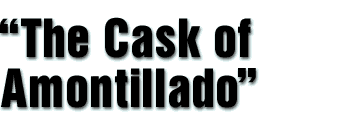|
 |
||
|
Mario Cavalli on the adaptation of Poe's short story |
The inscription inside my copy of The Penguin Edgar Allan Poe reads: ‘For Mario - hope it inspires you. X Rich ps. p274 for the CASK... + 127 A Descent Into The MAELSTROM’ - a helpful (and hopeful) gift from my prospective adaptor.
Rich (though I never call him that) Richard Deakin, big hearted, larger than life Welshman, father of my daughter’s best friend, novelist and playwright, of scholarly and sometimes comic works, often on literary figures, misunderstood or unrecognised in their own lifetime.
"If you ever do a short film, you should think about THE CASK OF AMONTILLADO"
Poe’s paranoid and murderous Renaissance drama might be a natural choice for Richard, with his interest in the psychology of misfits of the literary world, just the thing he might knock off over a wet weekend in November. Not really me though, thanks very much, even if the notion of translating Poe’s vision to film was admittedly intriguing.
Film’s capacity for creating compelling imaginary worlds, none more so than in animation, has always been at the root of my fascination with the medium. Naturally, I would be attracted to costume drama, part of the live action career I would eventually resume, emerging from my long digression into animation, I always supposed.
My drawing ability got me into the industry through the animation back door, when every other department was organised as a closed shop. I had, as a student, won a small scriptwriting competition and had produced and directed a short drama at a time when narrative film was frowned upon in our film schools and barely surviving as a theatrical experience. Animation, it seemed to me then, was quite fun, relatively easy to do and as good a way as any to get started. Sooner or later, I thought, I’d get back to my original career plan. Inevitably, it didn’t happen that way at all.
Gazing at a particularly cinematic figurative composition, ‘The Conversation’ by the Milton Avery - subtle colourist, friend and mentor to Mark Rothko and long time favourite (courtesy of the Whitney Museum poster shop) in the Cavalli household - I started to wonder at the surprisingly few examples of cinema emulating painting - as opposed to influencing painting - Avery’s picture being just one example of a recurring characteristic, from Edward Hopper to Eric Fischel.
With the possible exceptions of German Expressionist cinema or Antonioni’s The Red Desert, I could think of no example of an overtly ‘painterly’ approach to film design and narrative. Yet in animation, this was natural - normal practice, even in every other TV commercial...
Full article published in Filmwaves - Issue 8, Summer 1999. Subscribe now!
